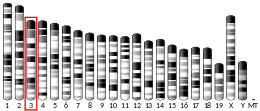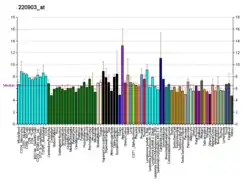| GFM1 | |||||||||||||||||||||||||||||||||||||||||||||||||||
|---|---|---|---|---|---|---|---|---|---|---|---|---|---|---|---|---|---|---|---|---|---|---|---|---|---|---|---|---|---|---|---|---|---|---|---|---|---|---|---|---|---|---|---|---|---|---|---|---|---|---|---|
| Identifiers | |||||||||||||||||||||||||||||||||||||||||||||||||||
| Aliases | GFM1, COXPD1, EFG, EFG1, EFGM, EGF1, GFM, hEFG1, G elongation factor, mitochondrial 1, G elongation factor mitochondrial 1, mtEF-G1 | ||||||||||||||||||||||||||||||||||||||||||||||||||
| External IDs | OMIM: 606639 MGI: 107339 HomoloGene: 6449 GeneCards: GFM1 | ||||||||||||||||||||||||||||||||||||||||||||||||||
| |||||||||||||||||||||||||||||||||||||||||||||||||||
| |||||||||||||||||||||||||||||||||||||||||||||||||||
| |||||||||||||||||||||||||||||||||||||||||||||||||||
| |||||||||||||||||||||||||||||||||||||||||||||||||||
| |||||||||||||||||||||||||||||||||||||||||||||||||||
| Wikidata | |||||||||||||||||||||||||||||||||||||||||||||||||||
| |||||||||||||||||||||||||||||||||||||||||||||||||||
Elongation factor G 1, mitochondrial is a protein that in humans is encoded by the GFM1 gene. It is an EF-G homolog.[5][6][7]
Eukaryotes contain two protein translational systems, one in the cytoplasm and one in the mitochondria. Mitochondrial translation is crucial for maintaining mitochondrial function and mutations in this system lead to a breakdown in the respiratory chain-oxidative phosphorylation system and to impaired maintenance of mitochondrial DNA. This gene encodes one of the mitochondrial translation elongation factors. Its role in the regulation of normal mitochondrial function and in different disease states attributed to mitochondrial dysfunction is not known.[7]
References
- 1 2 3 GRCh38: Ensembl release 89: ENSG00000168827 - Ensembl, May 2017
- 1 2 3 GRCm38: Ensembl release 89: ENSMUSG00000027774 - Ensembl, May 2017
- ↑ "Human PubMed Reference:". National Center for Biotechnology Information, U.S. National Library of Medicine.
- ↑ "Mouse PubMed Reference:". National Center for Biotechnology Information, U.S. National Library of Medicine.
- ↑ Gao J, Yu L, Zhang P, Jiang J, Chen J, Peng J, Wei Y, Zhao S (May 2001). "Cloning and characterization of human and mouse mitochondrial elongation factor G, GFM and Gfm, and mapping of GFM to human chromosome 3q25.1-q26.2". Genomics. 74 (1): 109–14. doi:10.1006/geno.2001.6536. PMID 11374907.
- ↑ Hammarsund M, Wilson W, Corcoran M, Merup M, Einhorn S, Grander D, Sangfelt O (Dec 2001). "Identification and characterization of two novel human mitochondrial elongation factor genes, hEFG2 and hEFG1, phylogenetically conserved through evolution". Hum Genet. 109 (5): 542–50. doi:10.1007/s00439-001-0610-5. PMID 11735030. S2CID 24508386.
- 1 2 "Entrez Gene: GFM1 G elongation factor, mitochondrial 1".
Further reading
- Bec G, Kerjan P, Zha XD, Waller JP (1990). "Valyl-tRNA synthetase from rabbit liver. I. Purification as a heterotypic complex in association with elongation factor 1". J. Biol. Chem. 264 (35): 21131–7. doi:10.1016/S0021-9258(19)30056-0. PMID 2556394.
- Motorin YuA; Wolfson AD; Orlovsky AF; Gladilin KL (1988). "Mammalian valyl-tRNA synthetase forms a complex with the first elongation factor". FEBS Lett. 238 (2): 262–4. doi:10.1016/0014-5793(88)80492-7. PMID 3169261. S2CID 45934458.
- Strausberg RL, Feingold EA, Grouse LH, et al. (2003). "Generation and initial analysis of more than 15,000 full-length human and mouse cDNA sequences". Proc. Natl. Acad. Sci. U.S.A. 99 (26): 16899–903. Bibcode:2002PNAS...9916899M. doi:10.1073/pnas.242603899. PMC 139241. PMID 12477932.
- Ota T, Suzuki Y, Nishikawa T, et al. (2004). "Complete sequencing and characterization of 21,243 full-length human cDNAs". Nat. Genet. 36 (1): 40–5. doi:10.1038/ng1285. PMID 14702039.
- Bhargava K, Templeton P, Spremulli LL (2005). "Expression and characterization of isoform 1 of human mitochondrial elongation factor G". Protein Expr. Purif. 37 (2): 368–76. doi:10.1016/j.pep.2004.06.030. PMID 15358359.
- Gerhard DS, Wagner L, Feingold EA, et al. (2004). "The status, quality, and expansion of the NIH full-length cDNA project: the Mammalian Gene Collection (MGC)". Genome Res. 14 (10B): 2121–7. doi:10.1101/gr.2596504. PMC 528928. PMID 15489334.
- Coenen MJ, Antonicka H, Ugalde C, et al. (2004). "Mutant mitochondrial elongation factor G1 and combined oxidative phosphorylation deficiency". N. Engl. J. Med. 351 (20): 2080–6. doi:10.1056/NEJMoa041878. hdl:2066/143650. PMID 15537906. S2CID 96906.
- Antonicka H, Sasarman F, Kennaway NG, Shoubridge EA (2006). "The molecular basis for tissue specificity of the oxidative phosphorylation deficiencies in patients with mutations in the mitochondrial translation factor EFG1". Hum. Mol. Genet. 15 (11): 1835–46. doi:10.1093/hmg/ddl106. PMID 16632485.
- Valente L, Tiranti V, Marsano RM, et al. (2007). "Infantile encephalopathy and defective mitochondrial DNA translation in patients with mutations of mitochondrial elongation factors EFG1 and EFTu". Am. J. Hum. Genet. 80 (1): 44–58. doi:10.1086/510559. PMC 1785320. PMID 17160893.
This article is issued from Wikipedia. The text is licensed under Creative Commons - Attribution - Sharealike. Additional terms may apply for the media files.




